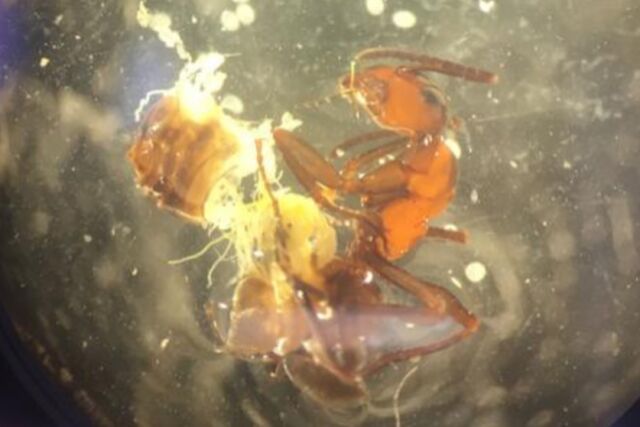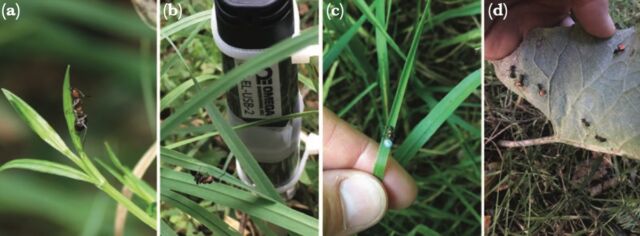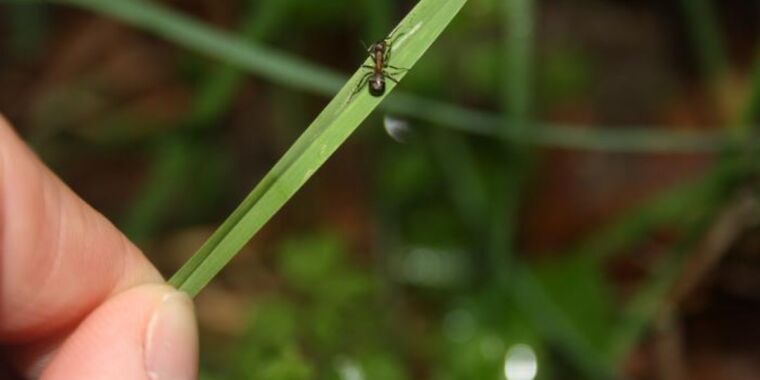
University of Copenhagen
Parasites that control and alter the behavior of their hosts are well-known in nature. Most notably, there is a family of zombifying parasitic fungi called Cordyceps—more than 400 different species, each targeting a particular insect species, whether it be ants, dragonflies, cockroaches, aphids, or beetles. In fact, Cordyceps inspired the premise of The Last of Us game and subsequent TV series. And earlier this month we reported on a study of how a parasitic worm (trematode) targets a particular species of marsh-dwelling brown shrimp (amphipod), turning the shrimp an orange hue and altering the host shrimp’s behavior.
Then there’s the lancet liver fluke, whose complicated life cycle relies on successfully invading successive hosts: snails, ants, and grazing mammals. (Some liver flukes have also been known to infect the occasional unfortunate human.) Scientists at the University of Copenhagen in Denmark have discovered that the way the liver fluke “zombifies” ants to alter their behavior incorporates a kind of “on/off” switch that, in turn, is dependent on temperature. The researcherse described their findings in a recent paper published in the journal Behavioral Ecology.
“Historically, parasites have never really been focused on that much, despite there being scientific sources which say that parasitism is the most widespread life form,” said co-author Brian Lund Fredensborg. “This is in part due to the fact that parasites are quite difficult to study. Nevertheless, the hidden world of parasites forms a significant part of biodiversity, and by changing the host’s behavior, they can help determine who eats what in nature. That’s why they’re important for us to understand.”
When liver flukes infect an ant, most of them lurk in the ant’s abdomen, wrapped in a protective capsule to protect them from stomach acid. One gallant liver fluke attaches itself to the ant’s brain, compelling the ant to clamp its mandibles near the top of a blade of grass, where it is more likely to be eaten by grazing animals like cows, sheep, or deer. The protective capsule then dissolves inside the new host’s intestines, and the liver flukes work their way to the liver via the bile ducts. The fluke that attached itself to the ant’s brain dies, sacrificing itself for its parasitic compatriots.

Brian Lund Fredensborg
The surviving flukes feed on their new host’s blood, become adults, and lay eggs, which the host excretes in its feces. Snails then saunter by leisurely and consume the feces, along with the fluke eggs. Those eggs hatch into larval flukes that reproduce asexually, reaching several thousand in number. The snails eventually cough up the larval flukes along with a bunch of mucus. Said mucus attracts ants, who eat it and ingest the larvae, ensuring that the cycle continues.
Fredensborg had previously studied the effects of liver fluke infection on infected ants in the laboratory and noticed that the ants were less likely to bite a leaf under hotter temperatures. Nobody had yet studied the effects of temperature or other environmental variables in the behavior of infected ants in the wild, because it’s so challenging to track and monitor the ants in the field.
For this latest experiment, Fredensborg chose to focus on four anthills in the Bidstrup Forests near Copenhagen, where both ants and lancet liver flukes are common. For 13 (non-consecutive) days, he and his then-graduate student, Simone Nordstrand Gasque (now a graduate student at Wageningen University in The Netherlands), observed the behavioral changes of infected ants, i.e., biting the tops of grass while tracking temperature and relative humidity over the course of the day. They also figured out how to glue colored and numbered tags to the rear ends of a subset of 172 ants so they could more closely study individual behavioral changes.

S. Nordstrand Gasque and B. Lund Fredensborg
The results confirmed the earlier laboratory experiments: Infected ants were much more likely to attach themselves to the top of a blade of grass when the temperature was low, sometimes staying up there all day if the weather stayed cool. As temperatures rose, the ants would release their death-bite and crawl back down, returning when the temperature dropped. It’s almost like the parasitic liver fluke waits for optimal conditions before turning on “zombie mode” in the ant’s brain. The authors suggest that this strategy evolved because it increases the liver fluke’s likeliness of transmission to a new grazing host, while protecting it from potentially lethal high temperatures.
“We found a clear correlation between temperature and ant behavior,” said Fredensborg. “We joked about having found the ants’ zombie switch. Getting the ants high up in the grass for when cattle or deer graze during the cool morning and evening hours, and then down again to avoid the sun’s deadly rays, is quite smart. Our discovery reveals a parasite that is more sophisticated than we originally believed it to be. But we still need to figure out which cocktail of chemical substances the parasite uses to turn ants into zombies.”








